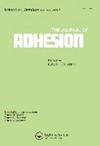考虑机械和腐蚀载荷的电池外壳结构粘接密封性研究
IF 2.3
4区 材料科学
Q2 ENGINEERING, CHEMICAL
引用次数: 0
摘要
本文章由计算机程序翻译,如有差异,请以英文原文为准。
Investigation of the leak tightness of structural adhesive joints for use in battery housings considering mechanical and corrosive loads
ABSTRACT Due to increasing legal requirements to reduce emissions from vehicle fleets, vehicle manufacturers are focusing on the electrification of the powertrain. In entirely electrically driven vehicles, the energy is stored in traction batteries integrated below the passenger cell between the axles and thus located in the vehicle’s wet area. Therefore, high requirements apply to the protection of the sensitive cells against mechanical stress as well as against moisture penetration. In addition, one of the main requirements for the connections of the battery housing is to ensure gas tightness over the entire service life. Adhesive bonding technology as a planar joining process offers the potential to produce functionally tight connections. However, there is a lack of reliable test methods for validating the long-term tightness of structural adhesive joints under mechanical and corrosive loads. For this reason, the paper deals with developing a test concept with laboratory-scale test specimens for leak testing under mechanical loading. Various leakage test methods investigate the leakage rate of structurally bonded joints. An analysis of the leakage rate under superimposed cyclic mechanical shear tensile loading follows this. The test method is validated on a specially developed sample battery housing on a laboratory scale.
求助全文
通过发布文献求助,成功后即可免费获取论文全文。
去求助
来源期刊

Journal of Adhesion
工程技术-材料科学:综合
CiteScore
5.30
自引率
9.10%
发文量
55
审稿时长
1 months
期刊介绍:
The Journal of Adhesion is dedicated to perpetuating understanding of the phenomenon of adhesion and its practical applications. The art of adhesion is maturing into a science that requires a broad, coordinated interdisciplinary effort to help illuminate its complex nature and numerous manifestations.
 求助内容:
求助内容: 应助结果提醒方式:
应助结果提醒方式:


